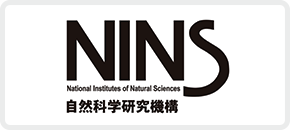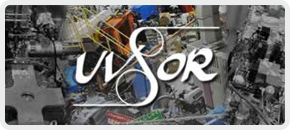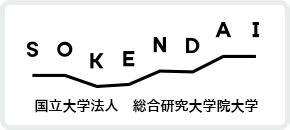Photoelectron Momentum Microscope for μm-material electronic and spin structure visualization
Highlights
カゴメ格子超伝導を担う電子軌道を解明 東北大―佐藤・中山グループと共同研究

カゴメ格子は、三角形が頂点を共有して周期的に配列した結晶対称性を有 します。この特殊な幾何学的対称性は、電子の強いフラストレーションの 原因となり、様々な量子現象を引き起こすことが理論的に予言されていま した。なかでも CsV3Sb5 は、カゴメ格子では珍しい、超伝導を示すこと が2020 年に発見され、特殊な結晶対称性の下でなぜ超伝導が発現するか、 興味が持たれていました。本研究で「V 電子と Sb 電子の協調関係という 新たな効果」が超伝導発現の重要なカギであることが示されました。
光電子運動量顕微鏡で明らかにしたグラファイト 原子1 層のステップ構造

グラファイトの結晶は炭素のハチの巣状の原子層が積み重なる構造を持ち ます。表面を層に平行にへき開切断すると、奇数層目と偶数層目とで、そ れぞれ鏡面に映した関係の 3 回対称の構造が表面に現れます。しかし、従 来の測定では両者の表面構造を合わせて観測していたため、6 回対称の データが得られていました。そのため、これまでグラファイトの電子状態 は6 回対称であることが「常識」とされてきました。本研究では光電子運 動量顕微鏡を活用し、今まで気付かれていなかったグラファイトへき開最 表面の奇数層目と偶数層目の電子状態の違いを発見し、原子 1 層のステッ プの可視化に成功しました。
光電子運動量顕微鏡:マイクロメートルの機能性 材料の電子状態を空間・運動量分解能:50nm・0.01 Å-1 で可視化

光電子分光は、X 線を試料表面に照射し飛び出す光電子を計測し、試料の 組成や電子物性を解明する分析法です。今回、UVSOR に最新の光電子分 光測定装置 Momentum Microscope を導入しました。不均一試料の 微小部分を拡大して観察できる顕微(microscope)機能と試料の物性を 決定づける電子のふるまい(運動量 momentum)を可視化する機能を1 つの装置で同時に実現します。本装置は主要な軽元素・遷移元素の内殻準 位を励起できる軟 X 線ビームラインに設置され、位置分解能 50 nm 、運 動量分解能 0.01 Å-1 、エネルギー分解能 20 meV を達成、試料を 9 K まで冷却でき、制限視野2 μm からの価電子帯分散やフェルミ面を測定す ることができます。本装置で初めて可能になる運動量分解顕微光電子分光 法は、表面・薄膜・配向分子・化合物結晶試料の原子レベルでの電子状態 解析を通じ、ナノ材料科学・量子デバイス工学を展開するうえで重要な手 法となります。
New Book released!

Textbook for photoelectron spectroscopy (in Japanese).
「光電子分光詳論」
authors: Fumihiko Matsui, Tomohiro Matsushita, and Hiroshi Daimon
ISBN: 978-4-621-30537-9 (Maruzen)
Photoelectron spectroscopy is widely used as a tool for investigating atomic structures and electronic states and clarifying physical properties, and is the basis for understanding physical physics and developing new materials. Advances in vacuum technology and the development of new light sources such as synchrotron radiation have made photoelectron spectroscopy an increasingly important method in the rapidly advancing materials science. On the other hand, in analysis, data that could not be seen until now is too visible now, so it is necessary to take a good look at the data itself. For that, it is necessary to return to the basics.
This book is a detailed commentary aimed at helping young researchers and students who begin to use photoelectron spectroscopy in earnest to learn the basics of photoelectron spectroscopy and analyze it by themselves. The two-dimensional anglar distribution woven by photoelectrons is very beautiful. This book is a guide to knowing and utilizing its beauty.
LINKS
ACCESS
愛知県岡崎市明大寺町字西郷中38番地
38 Nishigo-Naka, Myodaiji, Okazaki 444-8585, Japan
アクセス情報
Access Information
自然科学研究機構 分子科学研究所 明大寺キャンパス 極端紫外光実験棟 Bld.9 (MAP)
National Institutes of Natural Sciences Institute for Molecular Science Myodaiji Campus UVSOR Bld.9
分子科学研究所 明大寺キャンパスまでのアクセスはこちら
Click here(https://www.ims.ac.jp/en/about/campus/access.html) for the access to Myodaiji Campus
極端紫外光研究施設(UVSOR棟) 301号室 TEL: 0564-55-7201
UVSOR Synchrotron Facility Building Room 301






